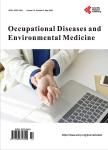Association between Respirable Dust Exposure and Respiratory Health Concerns among Workers in Apparel Processing Companies in Export Processing Zone (EPZ) in Machakos County, Kenya
Association between Respirable Dust Exposure and Respiratory Health Concerns among Workers in Apparel Processing Companies in Export Processing Zone (EPZ) in Machakos County, Kenya作者机构:Institute of Energy and Environmental Technology Jomo Kenyatta University of Agriculture and Technology (JKUAT) Nairobi Kenya Department of Environmental Health and Disease Control Jomo Kenyatta University of Agriculture and Technology (JKUAT) Nairobi Kenya
出 版 物:《Occupational Diseases and Environmental Medicine》 (职业病与环境医学(英文))
年 卷 期:2022年第10卷第4期
页 面:271-291页
学科分类:02[经济学] 0202[经济学-应用经济学] 020206[经济学-国际贸易学]
主 题:Apparel Respirable Dust Health Concerns Occupational Safety and Health
摘 要:Apparel processing is an essential industry in providing clothing needs for the population. The Export Processing Zone (EPZ) in Kenya employs many employees. Garment processing releases respirable dust particles, thus exposing workers to risks to the respiratory system. The study determined the respirable dust health concerns among workers in Apparel Processing Companies (APCs) in EPZ in Machakos County, Kenya. A cross-sectional descriptive design was employed where four companies were studied. Three hundred and sixty-seven participants were selected through systematic random sampling. Data was collected using questionnaires and Interview guides. The study established that workers were exposed to respirable dust PM2.5 ranging from 40.89 ± 24.0 μg·m−3 to 87.49 ± 45.2 μg·m−3 with a mean of 65.61 ± 31.5 μg·m−3. While PM2.5 ranged from 63.59 ± 21.2 μg·m−3 to 313.41 ± 468.0 μg·m−3. With a mean of 104.02 ± 26.0 μg·m−3. Workers complained of different respirable dust-related diseases. The most prevalent conditions were sneezing and coughing (86.4%), chest pains (41.1%), blocked chests (36.8%), and allergic reactions to dust (18.3%). The APC should develop an OSH management system that includes;a dust management policy, dust monitoring, Risk Assessments, Engineering controls installations, medical examination, Training on dust management, PPE provision, and use enforcement.



